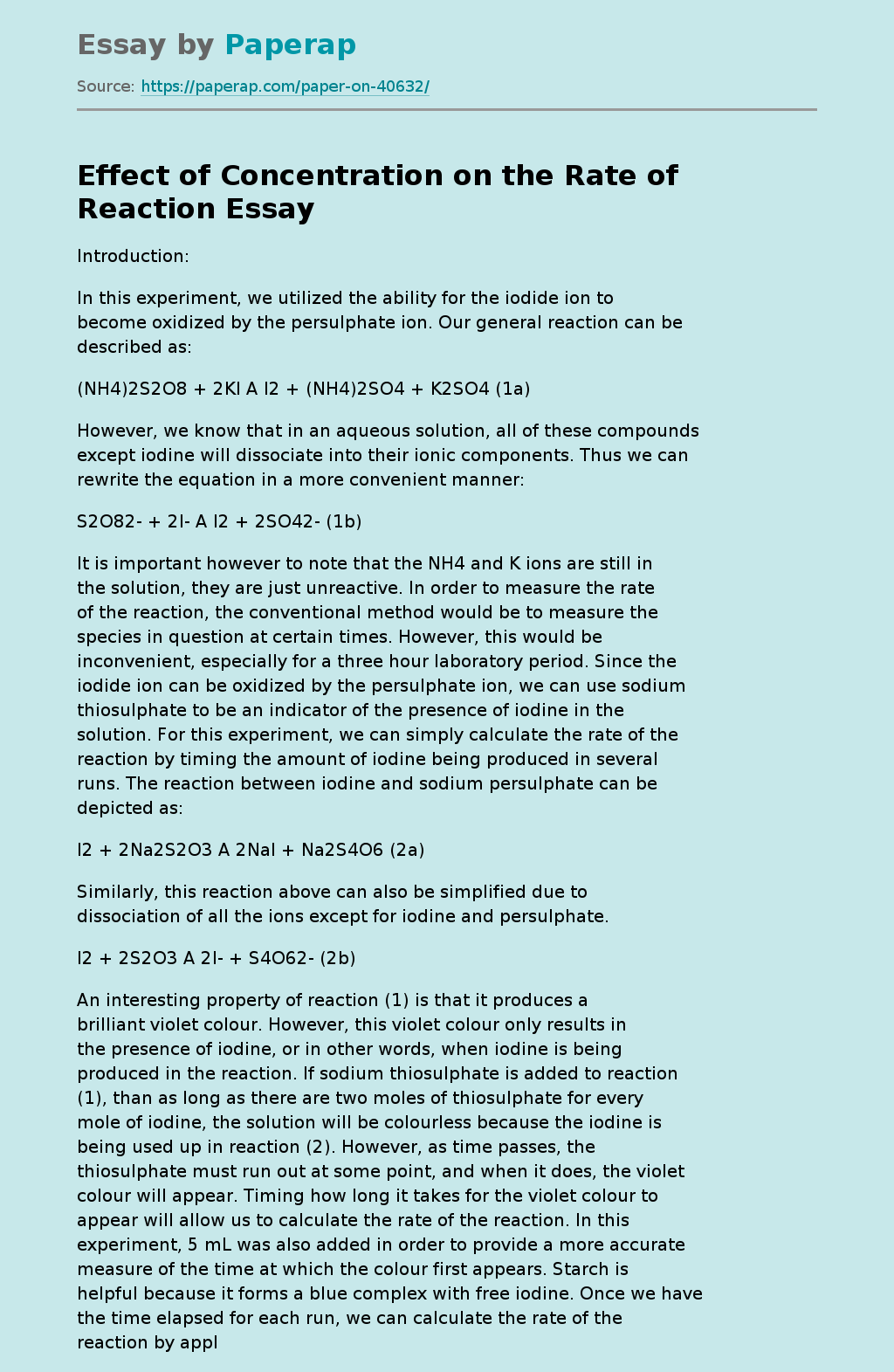Effect of Concentration on the Rate of Reaction
In this experiment, we utilized the ability for the iodide ion to become oxidized by the persulphate ion. Our general reaction can be described as: (NH4)2S2O8 + 2KI A I2 + (NH4)2SO4 + K2SO4 (1a) However, we know that in an aqueous solution, all of these compounds except iodine will dissociate into their ionic components. Thus we can rewrite the equation in a more convenient manner: S2O82- + 2I- A I2 + 2SO42- (1b)
It is important however to note that the NH4 and K ions are still in the solution, they are just unreactive.
In order to measure the rate of the reaction, the conventional method would be to measure the species in question at certain times. However, this would be inconvenient, especially for a three hour laboratory period. Since the iodide ion can be oxidized by the persulphate ion, we can use sodium thiosulphate to be an indicator of the presence of iodine in the solution. For this experiment, we can simply calculate the rate of the reaction by timing the amount of iodine being produced in several runs.
The reaction between iodine and sodium persulphate can be depicted as: I2 + 2Na2S2O3 A 2NaI + Na2S4O6 (2a)
Similarly, this reaction above can also be simplified due to dissociation of all the ions except for iodine and persulphate. I2 + 2S2O3 A 2I- + S4O62- (2b)
An interesting property of reaction (1) is that it produces a brilliant violet colour. However, this violet colour only results in the presence of iodine, or in other words, when iodine is being produced in the reaction.
If sodium thiosulphate is added to reaction (1), than as long as there are two moles of thiosulphate for every mole of iodine, the solution will be colourless because the iodine is being used up in reaction (2). However, as time passes, the thiosulphate must run out at some point, and when it does, the violet colour will appear. Timing how long it takes for the violet colour to appear will allow us to calculate the rate of the reaction. In this experiment, 5 mL was also added in order to provide a more accurate measure of the time at which the colour first appears. Starch is helpful because it forms a blue complex with free iodine.
The change in S2O8-2 is simply half the concentration of S2O3-2 because in reaction (2), the consumption of iodine and persulphate has a 1:2 ratio. Thus, the consumption of iodine can be seen as half the consumption of persulphate (S2O3-2). After calculating the rate of the reaction, the rate constant can be found by using the equation: Rate = k [ S2O82-]m[I-] n
By comparing 2 sets of data at a time from 2 different runs, the order exponents m and n can be calculated, and thus, we can write the rate law for the iodide-persulphate reaction. We should also expect that the expected relationships between the concentration of S2O8-2 and the rate of reaction and rate constant might not always be extremely accurate in this experiment. When dealing with ions, we must always consider the ionic strength of the ions involved. The rate of the reaction will increase as the ionic strength gets stronger, thus, we will not always see a perfect linear relationship between [S2O8-2] and the rate of the reaction and the rate constant.
The purpose of this experiment was to perform many trials of the same experiment, varying only the concentrations of certain ionic compounds in order to determine the affect of concentration on the rate of a reaction. By varying the concentration of different compounds for each run while keeping other factors constant, we were able to obtain experimental data that would give us a relationship between concentration and reaction rate.
Effect of Concentration on the Rate of Reaction. (2016, Nov 07). Retrieved from https://paperap.com/paper-on-40632/

